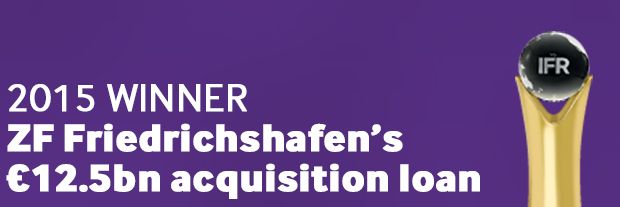A change of gear
German automotive systems supplier ZF Friedrichshafen’s jumbo €12.5bn loan backing its transformational acquisition of US rival TRW Automotive set a new standard for large-scale non-investment grade European M&A loan financing. The deal proved an overwhelming success despite a challenging timeframe and the size of the financing.
The transaction helped create a top three global automotive supplier with pro forma sales of over €30bn and more than 130,000 employees.
The European loan market had already welcomed the return of big ticket M&A with Germany’s Bayer closing a US$14.2bn loan in June 2014 to back its purchase of Merck & Co’s consumer goods business. However, a multi-billion acquisition loan for an unrated and relatively unknown borrower was an altogether different proposition.
“This was unknown territory. The company had no established international banks in its relationship group. The deal was transformational not only in putting the company onto the international stage but also in the way the company funded itself,” said Paul Gibbs, head of Western European loans, structuring and syndication at Citigroup.
ZF secured fully committed financing from underwriters Citigroup and Deutsche Bank on a confidential basis prior to the merger announcement on September 15 2014, providing certain funds for the acquisition and comfort to both ZF and TRW.
The financing comprised a 364-day bridge loan split between US$3.5bn and €4.79bn, initially paying 225bp over Libor/Euribor; a three-year term loan split between US$1.5bn and €1.34bn, initially paying 250bp; and a five-year term loan split between US$500m and €612m, initially paying 275bp.
Syndication was planned as a two-stage process, with an early-bird phase launched in September to relationship banks and banks that had expressed interest in the transaction. Such was the overwhelming response from the market, however, that the planned general syndication was scrapped.
The deal closed in early October after a total of 22 banks out of the 23 invited joined the two underwriters.
The lightning-fast syndication strategy effectively minimised the underwriting period for the two coordinating banks, which was important considering the size of their commitments, while limiting the number of banks in the syndicate created a new relationship bank group for the enlarged ZF company.
In addition, lending banks were comforted by a clear deleveraging story. ZF placed a €2.2bn Schuldschein in January 2015 – the largest-ever corporate Schuldschein – and followed that benchmark deal by placing €5.4bn-equivalent of bonds in April 2015, fully replacing the bridge loan element of the loan.
Although the financing closed in October 2014, the underlying acquisition completed on May 15 2015, making the loan eligible for an IFR award this year.
To see the digital version of the IFR Review of the Year, please click here .
To purchase printed copies or a PDF of this report, please email gloria.balbastro@tr.com .



